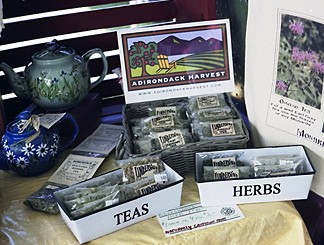Promoting local foods is paying off, CU research shows
By Kara Dunn
In northern New York, more food is going directly from farm to consumer, cutting out the middleman and saving thousands of miles in food shipments.
But, "there is tremendous room to grow the local share of the total food bill for New York's North Country region," says Duncan Hilchey of Cornell's Community and Rural Development Institute (CaRDI).
Hilchey, a senior extension associate, studies agriculture and food system indicators to set a comparative baseline for the North Country Regional Foods Initiative to use to evaluate anticipated growth of the local foods sector in northern New York.
"In 2002, the direct-to-consumer share of the total regional food expenditure of $936 million was almost $3.4 million – that is only one-third of 1 percent of the total," Hilchey says.
His analysis of the latest U.S. Department of Agriculture Census of Agriculture shows that:
- in 2002, 11 percent of northern New York farms sold directly to consumers, up from almost 7 percent in 1992, increasing direct-to-consumer farm sales to more than $3 million, up from $1.3 million;
- from 1997 to 2002, the number of fruit and vegetable farms increased almost 6 percent in the North Country.
Furthermore, farms and farm stands participating in grant-funded promotions through one regional program, Adirondack Harvest, report 19 percent more customers on average and an average increase in gross sales of 16 percent compared with past years.
Farmers' markets reported similar numbers: 21 percent more customers, 17 percent more gross sales. And stores taking advantage of promoting local products saw a 10 percent increase in customers with 11 percent more in gross sales in 2007, says Kathryn Lang, coordinator of the North Country Regional Foods Initiative.
The numbers reflect a growing trend of buying locally and "going green."
"North Country agricultural producers also have growing opportunities for increasing direct wholesaling, such as selling to restaurants, resorts and colleges," Hilchey notes. "It is great to see innovative programs helping to make the links between the producers and buyers."
Chambers of Commerce and regional agencies have embraced the local products promotion effort that drove visitors to regional farms in 2007 for spring open houses at greenhouses and fall harvest season tours.
"As our society learns about the benefits of eating locally, they want to enjoy the 'local food experiences' of their destinations as well," says Carol Joannette, the Lake Placid/Essex County Convention and Visitors Bureau vice president. "By educating restaurants on the benefits of serving locally grown foods and by promoting the farmers' markets, we provide outlets for our visitors to experience the flavors of the Adirondacks, thereby enhancing their visit."
The North Country Regional Foods Initiative project team includes representatives of each Cornell Cooperative Extension office in northern New York and CaRDI. The team has a $60,000 federal Economic Development Administration University Center grant from the U.S. Department of Commerce.
Kara Dunn is a freelance writer in Mannsville, N.Y.
Media Contact
Get Cornell news delivered right to your inbox.
Subscribe